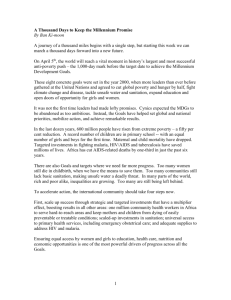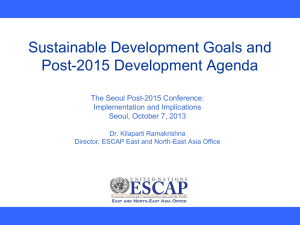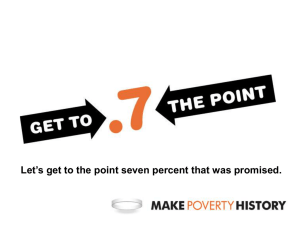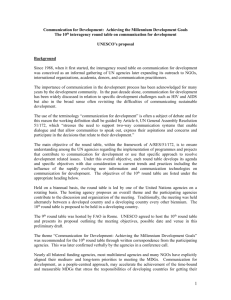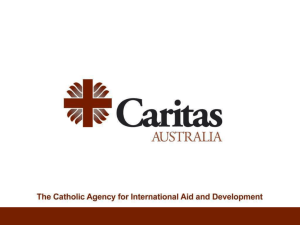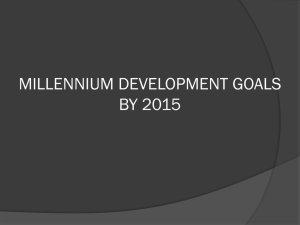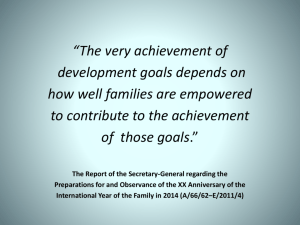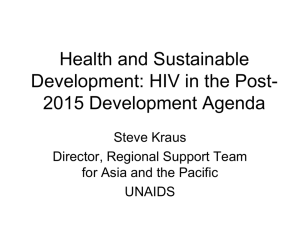Section I: Overview
advertisement
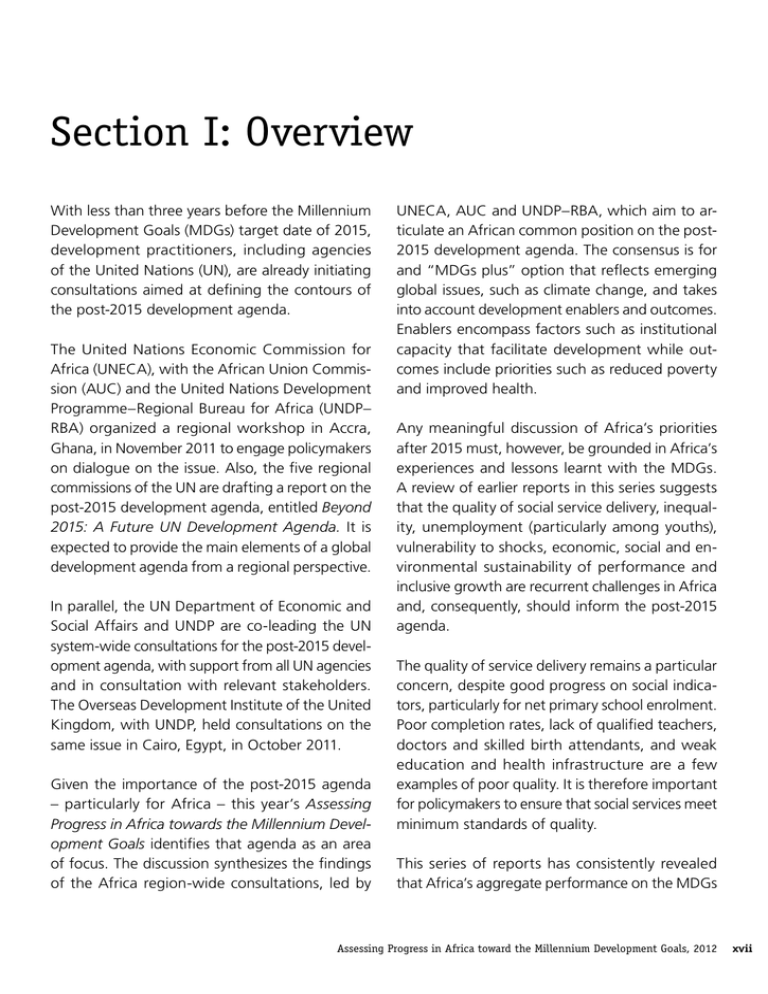
Section I: Overview With less than three years before the Millennium Development Goals (MDGs) target date of 2015, development practitioners, including agencies of the United Nations (UN), are already initiating consultations aimed at defining the contours of the post-2015 development agenda. The United Nations Economic Commission for Africa (UNECA), with the African Union Commission (AUC) and the United Nations Development Programme–Regional Bureau for Africa (UNDP– RBA) organized a regional workshop in Accra, Ghana, in November 2011 to engage policymakers on dialogue on the issue. Also, the five regional commissions of the UN are drafting a report on the post-2015 development agenda, entitled Beyond 2015: A Future UN Development Agenda. It is expected to provide the main elements of a global development agenda from a regional perspective. In parallel, the UN Department of Economic and Social Affairs and UNDP are co-leading the UN system-wide consultations for the post-2015 development agenda, with support from all UN agencies and in consultation with relevant stakeholders. The Overseas Development Institute of the United Kingdom, with UNDP, held consultations on the same issue in Cairo, Egypt, in October 2011. Given the importance of the post-2015 agenda – particularly for Africa – this year’s Assessing Progress in Africa towards the Millennium Development Goals identifies that agenda as an area of focus. The discussion synthesizes the findings of the Africa region-wide consultations, led by UNECA, AUC and UNDP–RBA, which aim to articulate an African common position on the post2015 development agenda. The consensus is for and “MDGs plus” option that reflects emerging global issues, such as climate change, and takes into account development enablers and outcomes. Enablers encompass factors such as institutional capacity that facilitate development while outcomes include priorities such as reduced poverty and improved health. Any meaningful discussion of Africa’s priorities after 2015 must, however, be grounded in Africa’s experiences and lessons learnt with the MDGs. A review of earlier reports in this series suggests that the quality of social service delivery, inequality, unemployment (particularly among youths), vulnerability to shocks, economic, social and environmental sustainability of performance and inclusive growth are recurrent challenges in Africa and, consequently, should inform the post-2015 agenda. The quality of service delivery remains a particular concern, despite good progress on social indicators, particularly for net primary school enrolment. Poor completion rates, lack of qualified teachers, doctors and skilled birth attendants, and weak education and health infrastructure are a few examples of poor quality. It is therefore important for policymakers to ensure that social services meet minimum standards of quality. This series of reports has consistently revealed that Africa’s aggregate performance on the MDGs Assessing Progress in Africa toward the Millennium Development Goals, 2012 xvii Overview masks wide income, gender and spatial inequalities in accessing social services. Left unchecked, these trends are likely to lead to social tensions and unravel progress made on the MDGs. Hence it is imperative that policymakers design and implement policies that address inequalities, promote social cohesion and sustain Africa’s progress on the MDGs. Sub-regionally, North Africa still outperforms on most MDGs, and may provide opportunities for sharing experience with other sub-regions (given differences in contexts, of course). Nationally, variations in performance often reflect differences in initial conditions. Sub-national variations, though, tend to be marked by gender and spatial disparities in outcomes. This year’s report also underscores the poor capacity of Africa’s recent rapid growth to commensurately boost jobs and reduce poverty. Contributing to this pattern is the dependence by several African countries on primary commodity exports and capital-intensive extractive industries, which have few or no linkages with other sectors of the economy. Collectively, these factors create and reinforce the “enclave” structure of these countries, which undermines their capacity to translate economic growth into strong job growth and poverty reduction. The past decade has laid bare the vulnerabilities of countries to socio-economic and climate-related shocks – as seen in the global financial crisis, sharp increases in food prices, the intensity and frequency of natural hazards and recurrent conflicts. The post-2015 agenda must seek to promote African resilience by addressing associated vulnerabilities. Economic activity should reflect efforts to adapt to and mitigate the effects of climate change, as well as to move towards a low-carbon growth path. The MDG experience is characterized by large and persistent variations in performance across subregional, national and sub-national jurisdictions. xviii These broad outlines find expression in this year’s Assessing Progress in Africa towards the Millennium Development Goals, and offer a perspective on the continent’s development priorities for the post-2015 development agenda. Assessing Progress in Africa toward the Millennium Development Goals, 2012 Overview Table 1 Africa’s MDGs performance at a glance, 2012 Goals and Targets (from the Millennium Declaration) Status Remarks • $1.25-a-day poverty in Africa (excluding North Africa) declined from 56.5% to 47.5% during 1990–2008 • • • Average enrolment exceeds 80% Issues of quality remain Most countries are not expected to meet the completion target • • Good progress at primary level but weak parity at secondary and tertiary levels of education High representation in parliament Off track • Declining, but slowly Goal 5: Improve maternal health Off track • Declining, but slowly Goal 6: Combat HIV/AIDS, malaria and other diseases • Off track HIV/AIDS on the decline, especially in Southern Africa, due to behavioural change and access to antiretroviral therapy Goal 7: Ensure environmental sustainability On track: improved water supply • • Few countries have reforestation plans Emissions minimal for most countries with little increase Most countries reduced consumption of ozonedepleting substances by more than 50% Goal 1: Eradicate extreme poverty and hunger Off track Goal 2: Achieve universal primary education On track: net enrolment Goal 3: Promote gender equality and empower women On track Goal 4: Reduce child mortality • Africa’s recent MDG performance and the Caribbean, and Western Asia. This is both remarkable and commendable, though complacency must not be allowed creep in. Africa’s progress on the MDGs is gaining momentum. The continent continues to make steady progress on most of the goals. And even though it is unlikely to achieve all the targets by 2015, the rate of progress on several indicators – including primary school enrolment, gender parity in primary school enrolment, the proportion of seats held by women in national parliament, HIV/AIDS prevalence rates and the share of women in nonagricultural wage employment – is accelerating (table 1). Indeed, in some cases Africa exceeds regions such as South-eastern Asia, Latin America Poverty is declining slowly and decent jobs are hard to find Both the rate of poverty and the absolute number of poor in Africa declined during 1990–2008. Excluding North Africa, the rate of poverty in Africa fell from 56.5 per cent to 47.5 per cent, driven in part by strong economic growth of the past decade and a decline in the proportion of workers below the poverty line ($1.25 a day). Nevertheless, decent jobs are at a premium in Africa as the majority of jobs are in the informal sector, which generally has Source: Computations from UNSD, accessed December 2011. Assessing Progress in Africa toward the Millennium Development Goals, 2012 xix Overview low incomes, low productivity and poor working conditions. Vulnerable employment accounts for some 70 per cent of employment growth – and is largely overrepresented by women. Food price increases are a barrier to reducing malnutrition The proportion of children under five who are malnourished in Africa (excluding North Africa) declined only marginally, between 1990 and 2009, despite a reduction in the poverty rate. Contributing to the sluggish decline was the continued escalation in food prices, which has invariably had an adverse impact, particularly on the food budgets of lower-income groups. Girls and rural dwellers are the most affected. More children are in primary school, but retaining them requires more effort Net primary enrolment in most African countries shows tremendous gains, with ratios exceeding 90 per cent in several countries. Completion rates, however, have seen little progress, and are as low as 33 per cent in some countries. Predictably, dropout rates are higher among girls than boys. Teacher absenteeism, late age entry by children in primary school cycles, poor health and nutritional status of pupils, financial constraints, distance to school and quality of educational facilities are some of the factors affecting educational quality and completion rates. Gender parity and women’s empowerment – a glass half full African countries have made significant strides in promoting gender parity in primary education. But they need to do more at secondary and tertiary levels to fully exploit women’s intellectual capacities. And although gender parity in paid xx non-agricultural employment is observed in the services sector (where women usually outnumber men), the reverse is true for higher-paying industrial jobs, which may stoke gender wage disparities because wages differ across sectors, skills and occupations. In politics, Africa needs to move beyond women’s participation to improving their capacity for contributing to development discussions and outcomes. Lagging health indicators Performance on health indicators such as infant, under-five and maternal mortality is still improving but not fast enough to achieve the goals. Immunization coverage, in contrast, has expanded rapidly and only two countries record less than 50 per cent coverage. Access to contraceptives is reducing maternal deaths Progress in reducing maternal deaths stems largely from declining fertility rates, helped by greater access to contraceptives. Yet almost one in four women in Africa who wish to space or delay their next pregnancy cannot do so because of lack of access to contraceptives, failure to empower women to use contraceptives and a mismatch between the types of contraceptives desired and those provided. Funding cuts threaten progress on the HIV/ AIDS front Africa appears to be starting to win the battle against HIV/AIDS. This is evidenced by a fall in the prevalence rate (particularly among women), a steep decline in the regional rate of new infections (the incidence rate), a reduction in the number of AIDS-related deaths and a drop in mother-to-child transmission of HIV/AIDS. Behavioural change Assessing Progress in Africa toward the Millennium Development Goals, 2012 Overview and access to antiretroviral therapy (ART) have underpinned the HIV/AIDS turnaround in Africa. Sustaining access to ART in an uncertain funding environment will, however, present a challenge to the countries most affected by the disease. Indeed, the announced cancellation of Round 11 of the Global Fund to Fight AIDS, Tuberculosis and Malaria (the Global Fund) could lead to reversals in other vertical funding schemes.1 Malaria-related deaths are down but access to effective drugs is limited Malaria mortality rates in Africa have declined by more than a third since 2000 owing to increased prevention and control measures. But the most effective treatment regimens – artemisinin-based combination therapies – still account for only a tiny portion of total treatment. Environmental challenges persist Poor sanitation, limited access to improved drinking water sources and declining forest cover are among the most pressing environmental challenges facing the continent – and climate change is likely to make them worse. But more positively, carbon dioxide (CO2) emissions have stabilized in most African countries, and the majority of countries have lowered their consumption of ozone-depleting substances. Furthermore, twenty-seven countries have listed improvements in the share of protected terrestrial and marine areas. 1 Programmes that target resources at specific health problems. Official development assistance is important, but diversifying the assistance portfolio is crucial Official development assistance (ODA) in Africa’s development is important, but African policymakers are urged to diversify their portfolio of such funding so as to maximize the volume of resources and minimize exposure to funding shocks. In addition, promoting African products’ access to global markets provides an opportunity for growing out of aid. Trade is vital for Africa’s development, and the continued growth of Aid for Trade (AfT) commitments, which are growing faster than ODA, are welcomed. Still, AfT’s concentration in a few countries is a concern that requires an immediate remedy. Informing the post-2015 agenda Accelerating progress to achieve the MDGs will require an integrated approach that takes into account the inter-linkages among goals and indicators. Yet it is not enough to reach the MDGs– progress must be kept up after that to make a difference to the lives of ordinary people. That momentum will require policymakers to ensure equal access to basic social services without compromising such services’ quality. Sustainability also hinges on the capacity of African countries to continue providing critical services such as ART and other essential drugs, even without vertical funds. Ultimately, African countries will have to transform their economies in ways that not only support rapid and inclusive growth but also generate enough domestic resources to offset shortfalls in external financing. Assessing Progress in Africa toward the Millennium Development Goals, 2012 xxi
